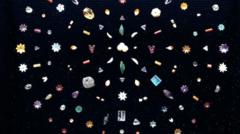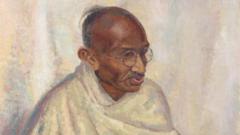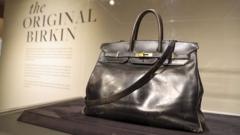The upcoming sale at Sotheby's has ignited a debate on whether sacred historical artifacts should be commodified, raising concerns among scholars and spiritual leaders alike.
Buddha’s Relics: Dazzling Jewels Up for Auction Raise Ethical Questions

Buddha’s Relics: Dazzling Jewels Up for Auction Raise Ethical Questions
An auction of jewels linked to the Buddha's remains draws global controversy over cultural heritage.
On Wednesday, Sotheby's Hong Kong will auction an extraordinary collection of jewels believed to be linked to the Buddha's remains, captivating collectors while provoking a significant ethical discourse. This collection, which includes nearly 1,800 gems—such as pearls, rubies, and sapphires—was unearthed from a sacred site in northern India over a century ago, illuminating the ancient world with its historical significance.
Originally discovered during a 1898 excavation led by British estate manager William Claxton Peppé, these artifacts were found within a stupa near Lumbini, the birthplace of the Buddha. The relics, including inscribed bone fragments attributed to the Buddha himself, have largely remained hidden in private ownership, marked as one of modern archaeology's most startling finds. Nicolas Chow, president of Sotheby's Asia, characterizes the collection as "among the most extraordinary archaeological discoveries of all time."
Yet as the auction date approaches, controversy brews. With the jewels intimately tied to India's spiritual heritage, experts question the ethical implications of their sale. “Are the relics of the Buddha a commodity?” asks Naman Ahuja, a Delhi-based art historian, echoing concerns about cultural ownership and the authority to sell such cherished artifacts.
The Peppé family, now the custodians of the jewels, debated the possibility of donating them but encountered various obstacles, leading them to conclude that an auction would provide an equitable means of transferring the relics to the Buddhist community. Chris Peppé, the great-grandson of the original discoverer, suggested in a public statement that the auction could facilitate the gems' return to the rightful custodians while ensuring transparency.
Sotheby's has asserted adherence to due diligence in ensuring the provenance and legality of the sale. Nonetheless, critics like Ashley Thompson and Conan Cheong, art experts, remain apprehensive, raising ethical dilemmas surrounding the trade of human remains, especially when many Buddhist practitioners regard the gems as integral to spiritual artifacts.
Buddhist leaders are also alarmed by the sale, emphasizing the teachings that discourage seizing others' possessions without permission. Amal Abeyawardene of the British MahaBodhi Society articulated that historical evidence points to the Sakyamuni clan's rightful custodianship of such relics.
Historical context adds another layer of complexity to the story. William Peppé's initial find culminated in the distribution of the remains to various countries, while only a fraction, perceived as duplicates, remained with his descendants. The auction has sparked comparisons to other historical artifacts, such as the Koh-i-Noor diamond, which many Indians view as an emblem of colonial plunder.
As critics voice their concerns, some within the Peppé family argue against the commodification of the relics, noting that sacred items should not be objectified as mere art to be sold. Ultimately, the issue raises broader discussions about cultural repatriation and the responsibilities of modern custodianships. Chris Peppé concluded that despite the challenges in donating the relics, the auction serves as a path to ensure the items are treasured by those to whom they are most significant.

















